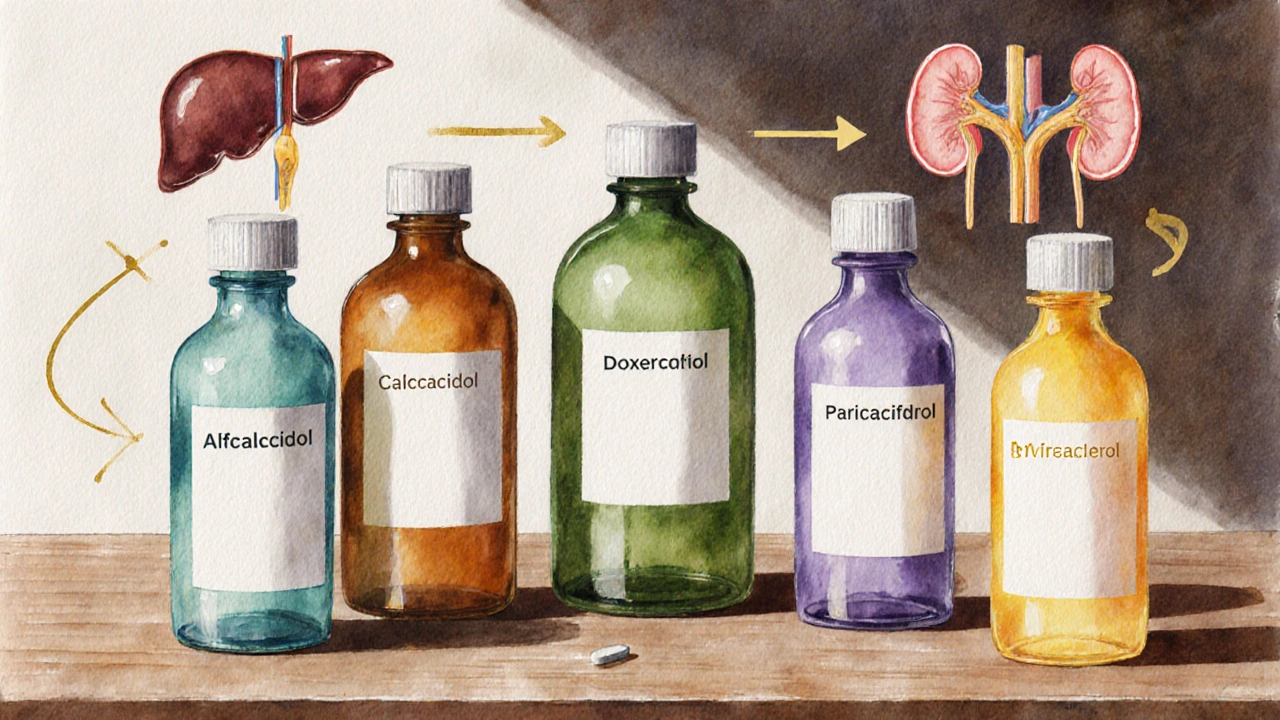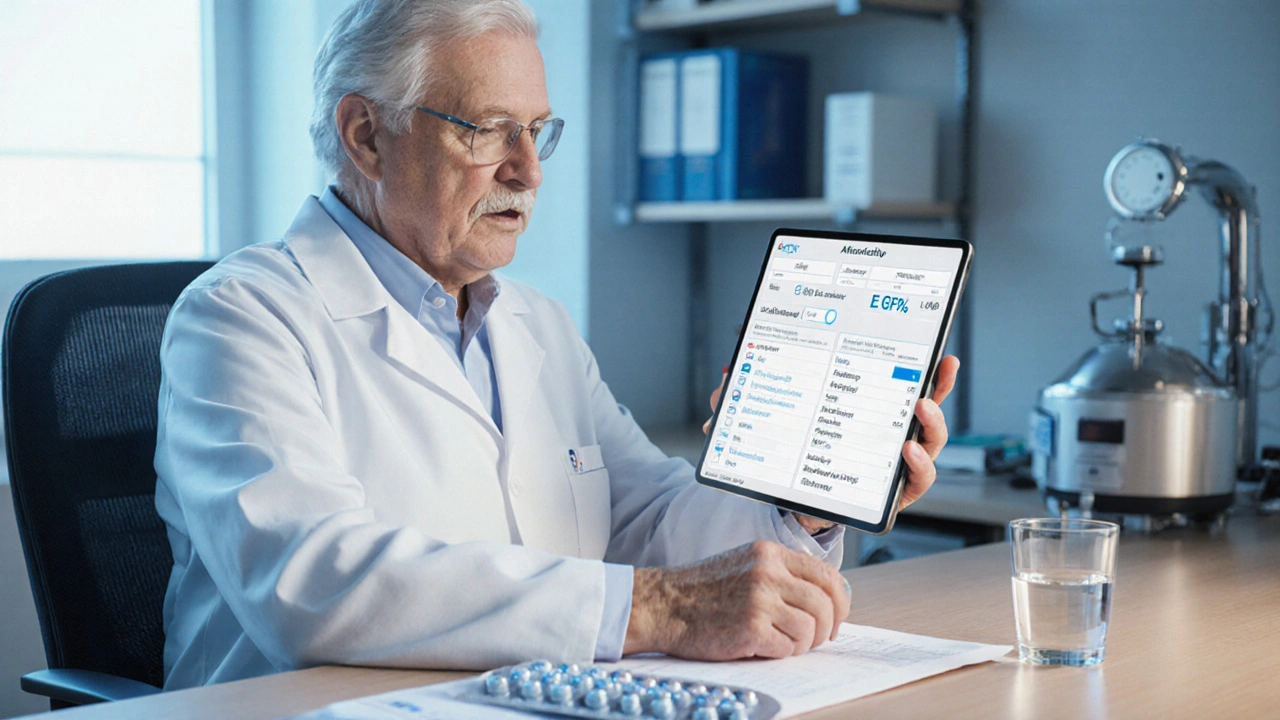Vitamin D Analog Selector
Key Takeaways
- Alfacalcidol (Alfacip) is a synthetic vitamin D₃analog that needs only one liver conversion step.
- Calcitriol, doxercalciferol and paricalcitol are also active forms but differ in kidney dependence and side‑effect profiles.
- Cholecalciferol (D3) and ergocalciferol (D2) are precursor vitamins; they work slower and are cheaper.
- Choosing the right agent hinges on kidney function, target calcium‑phosphate goals, and cost considerations.
- All agents share risk of hypercalcaemia - monitoring serum calcium and phosphate is essential.
What Is Alfacalcidol (Alfacip)?
When treating calcium‑deficiency disorders, Alfacalcidol is a synthetic vitamin D₃derivative sold under the brand name Alfacip. It mimics the active hormone calcitriol but requires only a single 25‑hydroxylation step in the liver, bypassing the kidney conversion that traditional vitamin D needs.
Because the kidney isn’t needed for activation, Alfacalcidol is especially useful for patients with chronic kidney disease (CKD) who cannot efficiently convert cholecalciferol to its active form.
How Alfacalcidol Works
Alfacalcidol binds to the vitamin D receptor (VDR) in target tissues, promoting intestinal calcium absorption, reducing parathyroid hormone (PTH) secretion, and helping remodel bone. The drug’s half‑life is about 12‑15hours, allowing once‑daily dosing for most indications.

Common Alternatives
Several other vitamin D analogs are available, each with distinct pharmacokinetic traits.
Calcitriol (brand name Rocaltrol) is the natural, fully‑active form of vitamin D₃. It bypasses all conversion steps, making it suitable for severe hypocalcaemia but also more prone to cause hypercalcaemia.
Doxercalciferol (generic name 1‑hydroxyvitaminD₂) requires only liver hydroxylation before the kidney activates it. It is mainly prescribed for secondary hyperparathyroidism in dialysis patients.
Paricalcitol is a synthetic analog designed to lower PTH with a reduced risk of raising calcium and phosphate levels. It is frequently used in CKD‑MBD (mineral‑bone disorder) management.
Cholecalciferol (vitaminD₃) is the natural dietary form. It needs two hydroxylations-first in the liver, then in the kidney-to become active. It is inexpensive and widely available as an over‑the‑counter supplement.
Ergocalciferol (vitaminD₂) is plant‑derived and follows the same two‑step activation pathway as cholecalciferol, but it is slightly less potent.
Side‑by‑Side Comparison
| Agent | Activation Requirement | Typical Indications | Usual Dose Range | Key Safety Concern | Cost (UK, 2025) |
|---|---|---|---|---|---|
| Alfacalcidol (Alfacip) | 1‑step liver 25‑hydroxylation only | CKD‑related hypocalcaemia, osteomalacia, rickets | 0.25‑1µg daily | Hypercalcaemia if overdosed | ~£12 per 30‑tablet pack |
| Calcitriol | Fully active, no conversion needed | Severe hypocalcaemia, renal osteodystrophy | 0.25‑0.5µg daily | High hypercalcaemia risk | ~£15 per 30‑tablet pack |
| Doxercalciferol | 1‑step liver hydroxylation; kidney converts to active | Secondary hyperparathyroidism in dialysis | 0.5‑1µg three times weekly | Hyperphosphataemia | ~£20 per 30‑tablet pack |
| Paricalcitol | Direct VDR agonist, minimal kidney activation | CKD‑MBD, PTH suppression | 0.04‑0.08µg daily | Lower calcium rise, but monitor phosphate | ~£30 per 30‑tablet pack |
| Cholecalciferol | 2‑step (liver + kidney) | General supplementation, mild deficiency | 400‑2000IU daily (10‑50µg) | Rare hypercalcaemia unless massive doses | ~£5 per 100tablet bottle |
| Ergocalciferol | 2‑step (liver + kidney) | Deficiency in vegans, malabsorption | 800‑2000IU daily (20‑50µg) | Similar to D3, slightly less potent | ~£6 per 100tablet bottle |
Decision Criteria: When to Pick Alfacalcidol Over Others
1. Kidney function - If eGFR is below 30mL/min/1.73m², agents that need kidney activation (cholecalciferol, ergocalciferol) become unreliable. Alfacalcidol’s liver‑only step keeps dosing predictable.
2. Speed of correction - For rapid calcium rise, calcitriol works fastest because it’s already active. Alfacalcidol follows closely, while D3/D2 take weeks to reach steady state.
3. Hypercalcaemia risk tolerance - Paricalcitol offers a gentler calcium increase, making it preferable for patients with borderline hypercalcaemia. Alfacalcidol still carries risk and needs regular labs.
4. Cost and availability - Over‑the‑counter D3 is cheapest, but if insurance covers prescription analogs, price differences shrink. Alfacalcidol sits in the middle.
5. Specific disease context - For renal osteodystrophy with secondary hyperparathyroidism, clinicians often start with Alfacalcidol or paricalcitol. For primary hypoparathyroidism, calcitriol remains the guideline‑recommended choice.

Practical Dosing and Monitoring Tips
- Start low. For most adults, 0.25µg of Alfacalcidol once daily is a safe entry point.
- Check serum calcium and phosphate 7‑10days after initiation, then monthly for the first three months.
- If calcium climbs above 2.65mmol/L, reduce dose by 25% or hold a dose.
- In CKD patients, also monitor PTH; a 20‑30% reduction after 6‑8weeks suggests adequate dosing.
- Educate patients to report symptoms such as muscle weakness, nausea, or excessive thirst-early signs of hypercalcaemia.
Similar monitoring applies to calcitriol and doxercalciferol, though the latter’s dosing interval (often thrice weekly) changes the timing of lab checks.
Next Steps for Clinicians and Patients
Evaluate renal function first, then decide whether a rapid‑acting analog (calcitriol) or a liver‑only activated drug (Alfacalcidol) best matches the therapeutic goal. If cost is a major barrier, consider high‑dose cholecalciferol and monitor closely, but recognize its slower onset.
Whichever agent you choose, embed a monitoring schedule into the patient’s care plan. Documentation of dose changes, lab trends, and symptom logs helps avoid dangerous calcium spikes.
Frequently Asked Questions
Can I switch from cholecalciferol to Alfacalcidol without a wash‑out period?
Yes. Because Alfacalcidol works through a different activation pathway, you can start the prescribed dose while tapering off over a week. Monitor calcium closely during the overlap.
What is the main advantage of Paricalcitol over Alfacalcidol?
Paricalcitol is designed to suppress PTH with a lower rise in serum calcium and phosphate, making it safer for patients who already have elevated calcium‑phosphate product.
Is Alfacalcidol approved for use in children?
In the UK, Alfacalcidol is approved for children with hypocalcaemia due to renal disease, but dosing is weight‑based and must be supervised by a paediatric endocrinologist.
How often should blood tests be done when I’m on Alfacalcidol?
Initially every 7‑10days, then monthly for three months, and later every 3‑6months once levels are stable.
Can I take calcium supplements together with Alfacalcidol?
Yes, but keep total calcium intake (diet+supplements) below 2g per day to reduce hypercalcaemia risk. Your doctor can advise the optimal amount.
